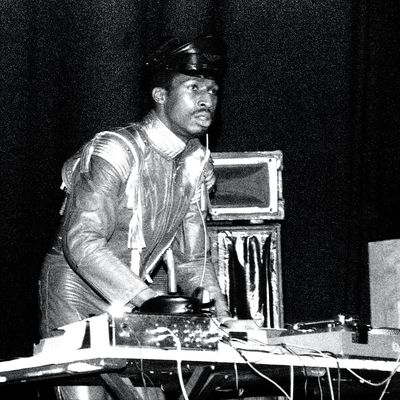
As told to Jennifer Vineyard
My first love was the vinyl. My father was a collector of records. He was into jazz. My mother and father broke up, and when I became a teenager, my second love was electronic items. I would open up the stereo in the living room, my sisters’ hairdryer, the iron, the washing machine, and I would try to put it back together. Now I’m getting my butt kicked by my older sisters. I’m just becoming Public Enemy Number One. I went to Samuel Gompers High School in the Bronx. That’s where I learned how these things worked.
I’d look at various DJs of that time era, and they were either doing things too slow, or the way that they were transitioning, I found them to be bumpy. It wasn’t smooth. It wasn’t clean. Eventually I figured out that in order to control the audio source, the vinyl, a lot of these DJs were using the tonearm. I was strongly advised to do it that way. But what was going on inside my head was, “How am I going to control this drum solo and make it seamless?”
So now I started studying turntables. How they work. I would lightly rest my hand on the turntable platter to see if the motor had enough muscle to be able to handle me moving my wrist back and forth over the vinyl. Many turntables failed. But there was a little-known company called Technics, and they had this ugly turntable called SL-120, and they were $75 apiece. Then I had to figure out, How can I hear the signal of the source in my ear? So that’s when I created this system that consisted of a single pole-double throw switch in a center position, to split the two signals. So when you click it to the left, I could hear the left turntable, two clicks to the right, I could hear the right turntable. Once I figured that out, then I had to think about the needles. Needles came in two classifications: They were conical and elliptical. The conical one stayed in the vinyl when I dragged it back and forth.
And after I figured out the turntable, I would mark the record with a grease pencil or a crayon, where the break lived, and all the intersecting points. So when I wanted to repeat a break all I had to do is just watch how many times the intersecting line passed the tone arm.
But then the problem was finding a buffer between the metal platter and the vinyl, so it could keep spinning while I was moving it back and forth. I went to a store, and I touched polyester, I touched silk, I touched cotton, and then I touched felt. And when I touched felt, I thought, “This could possibly work.” But it was flimsy. So I bought two pieces the size of an album, and I turned the iron on all the way, super hot, sprayed these circular felt pieces with spray starch, and I ironed them until they became stiff as a wafer. So now, I could put this wafer on top of the metal platter, the turntable, and put the record on top of the wafer. So now I had the fluidity of the disc moving freely while the turntable spun in a clockwise position.
Back then, the crowning achievement for me was that I had to do what all DJs wouldn’t do: physically put my hand on the record. My theory was everything should be controlled via the vinyl, the fingertips. But at that time, DJs used to treat vinyl like children. They used to carry these real soft brushes, and they would wipe the record down, and they would very carefully slide it back in the jacket. I was just pulling the record out of the jacket. It had crayon marks all over it! But that was a way that I could execute what was going on inside my head.
My first block party was 927 Fox Street, right in front of my building. It was a neighborhood park and people were all over me! It scared me, a little bit. I wasn’t even officially considered a DJ. I was just coming out with my makeshift sound system, it sounded like crap, and playing music. So the observers were like, “What is he doing?” And then as I started becoming more recognized and accepted as a DJ, it’s when I got hired to do parties. And the rest is a little like history, I guess!
I tried to talk on the microphone and play at the same time, but the science being brand-new to me, I found that I couldn’t do both. So I used to put the microphone on the other side of the table, and see if anyone could talk. Many people failed. The first person that was able to do that was Keith Wiggins. He had an aerobic type of style. He would make people do things, throw their hands up in the air! He was a perfect diversionary tactic, because people stopped looking at me. Now they were jamming.
*This is an expanded version of an article that appeared in the March 24, 2014 issue of New York Magazine.

